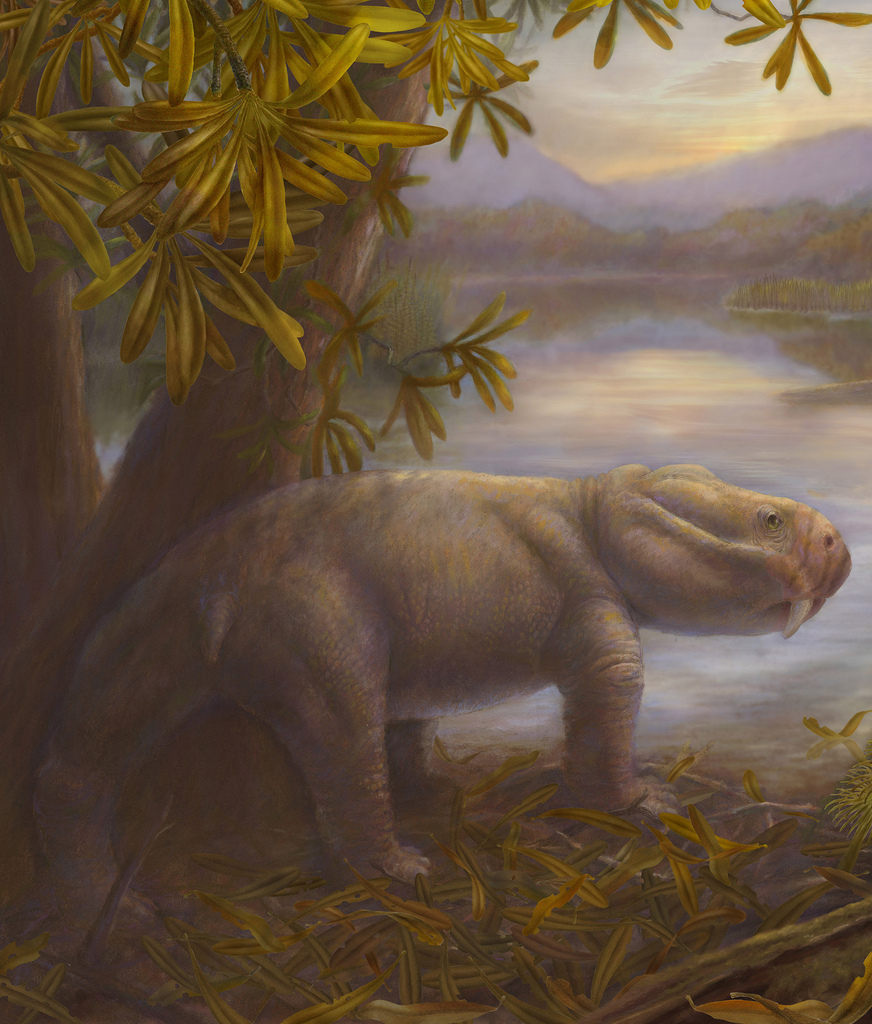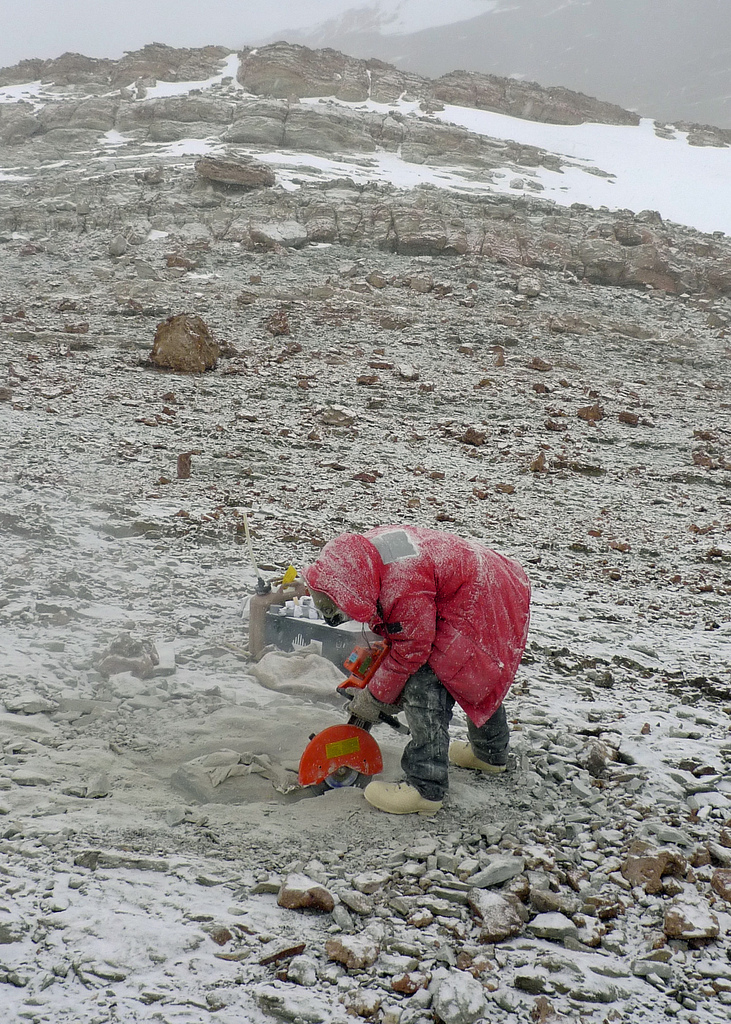Weird Dino Ancestors Boomed After Mass Extinction

Dinosaurs — or at least their ancestors — may have gotten an earlier start than once believed.
Bizarre four-legged creatures that resembled demonic dogs and predated dinosaurs branched out shortly after an extinction that wiped out most of life on land, according to a new study. Some of these creatures were the direct ancestors of dinosaurs, and their flourishing toehold in what is now Africa and Antarctica appears to have benefited from the clean slate of the mass extinction.
"We get the hint that the dinosaur radiation, which we don't really see in the fossil record until about 20 million years later, is really starting to take off in this region," said Christian Sidor, a biologist at the University of Washington and a research associate at the Field Museum of Natural History in Chicago. [See Images of the Weird Dinosaur Predecessors]
Vanished life
About 252 million years ago, 90 percent of marine life and about 70 percent of land animals vanished in what's known as the Permian-Triassic extinction event. No one knows why the mass extinction happened; theories include meteorite impacts, an uptick in volcanic activity or the release of carbon dioxide and methane, which would have caused major climate upheaval.
Among the weird creatures roaming the Earth at the time was the Dicynodon, a pig-size, four-legged animal that had the lizardlike look of the demonic dogs in 1984's "Ghostbusters." Just replace the canine teeth with beaks, and nix the glowing red eyes.
"They have short tails, two big tusks that are ever-growing like an elephant[’s], and they have a beak like a turtle," Sidor told LiveScience.
Sign up for the Live Science daily newsletter now
Get the world’s most fascinating discoveries delivered straight to your inbox.
Dicynodon and its contemporaries lived on Pangaea, a single landmass made of all of today's continents mashed together into one. The fossil record around the Permian extinction is spotty, with most paleontological research coming from a few fossil sites in Russia and in South Africa. Sidor and his colleagues wanted to broaden that range to better understand the post-extinction ecosystem across southern Pangaea, or what would today be Africa, South America, India, Australia and Antarctica.
Emerging ecosystems
To do so, the researchers analyzed fossils — some newly found and others in museum collections — from Tanzania, Zambia, Malawi and Antarctica, as well as the Karoo Basin in South Africa, where the Permian extinction record is long known. The project involved years of fieldwork, including at a base camp situated halfway between the McMurdo Station, a research base in Antarctica; and the South Pole, where rocks are periodically covered and uncovered by snow and ice.

"It's a huge logistical thing, as you might imagine," Sidor said.
The fossils revealed that the landscape 5 million years before the extinction, animal diversity was similar across all five sites, dominated particularly by the herbivorous Dicynodon. At the next fossil snapshot, 10 million years post-extinction, the five regions had diversified significantly.
After the Permian extinction, Dicynodon lost its perch as the dominant herbivore. Though it did not go extinct until about 200 million years ago, Dicynodon never regained its prominence. [The 10 Weirdest Animal Discoveries]
"After the extinction, things change dramatically," Sidor said. "The animals that are common in the Karoo are not the ones that are common in Tanzania."
In particular, Sidor said, the post-extinction landscape hosted many archosaurs, a group that includes crocodiles, birds, flying reptiles called pterosaurs and non-avian dinosaurs. An animal that may be the earliest known dinosaur, or at least the archosaur most closely related to dinosaurs — Nyasasaurus parringtoni—comes from Tanzania and lived about 245 million to 240 million years ago.
"There are a whole bunch of different archosaurs," Sidor said. "There were plant-eaters, large carnivores, armored forms — so they were really taking off into a variety of different body forms. It's not just the origin of dinosaurs we're tracing backwards, but seemingly a completely different ecosystem in Tanzania than what you see in South Africa."
It's not clear how two similar ecosystems could emerge to be so different after a mass extinction, Sidor said, but it's not an uncommon occurrence. He likened the change to politics: It's hard to dislodge an incumbent politician, but once you do, anyone could step in to fill the gap.
Some scientists believe that the Earth is now undergoing another mass extinction, due to human activity. If this is the case, Sidor said, the Permian extinction is a cautionary tale.
"Mass extinctions have unpredictable consequences," he said. "You couldn't tell, based on what was existing before the extinction, what's going to do well afterwards."
The researchers report their findings this week in the journal Proceedings of the National Academy of Sciences.
Follow Stephanie Pappas on Twitter and Google+. Follow us @livescience, Facebook & Google+. Original article on LiveScience.com.

Stephanie Pappas is a contributing writer for Live Science, covering topics ranging from geoscience to archaeology to the human brain and behavior. She was previously a senior writer for Live Science but is now a freelancer based in Denver, Colorado, and regularly contributes to Scientific American and The Monitor, the monthly magazine of the American Psychological Association. Stephanie received a bachelor's degree in psychology from the University of South Carolina and a graduate certificate in science communication from the University of California, Santa Cruz.










